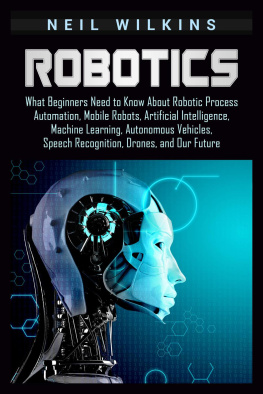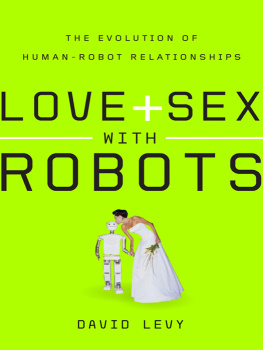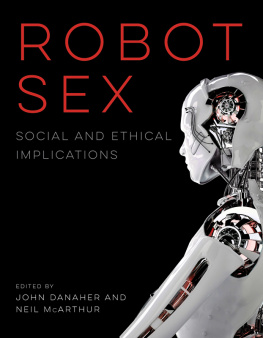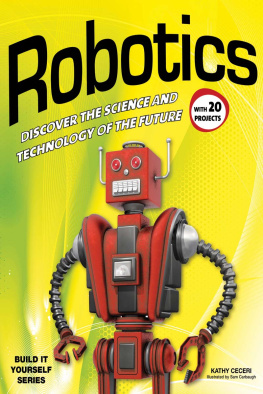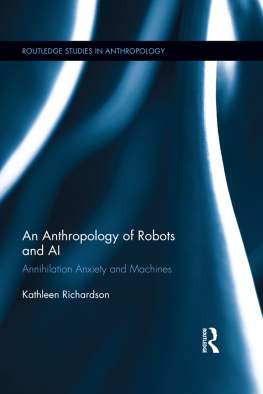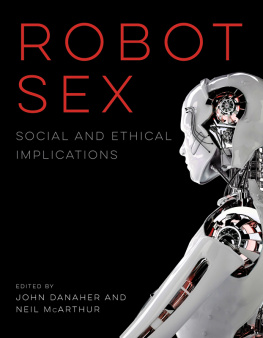2018 Massachusetts Institute of Technology
All rights reserved. No part of this book may be reproduced in any form by any electronic or mechanical means (including photocopying, recording, or information storage and retrieval) without permission in writing from the publisher.
This book was set in ITC Stone Serif Std by Toppan Best-set Premedia Limited. Printed and bound in the United States of America.
Library of Congress Cataloging-in-Publication Data
Names: Gunkel, David J., author.
Title: Robot rights / David J. Gunkel.
Description: Cambridge, MA : MIT Press, [2018] | Includes bibliographical references and index.
Identifiers: LCCN 2018013459 | ISBN 9780262038621 (hardcover : alk. paper)
Subjects: LCSH: Robots--Human factors. | Robots--Moral and ethical aspects.
Classification: LCC TJ211.49 .G88 2018 | DDC 179--dc23 LC record available at https://lccn.loc.gov/2018013459
ISBN: 978-0-262-03862-1
eISBN 9780262348553
ePub Version 1.0
Table of Contents
Guide
Preface
Whether we recognize it as such or not, we are in the midst of a robot invasion. The machines are now everywhere and doing virtually everything. We chat with them online, we play with them in digital games, we collaborate with them at work, and we rely on their capabilities to manage many aspects of our increasingly complex data-driven lives. Consequently, the robot invasion is not something that will transpire as we have imagined it in our science fiction, with a marauding army of evil-minded androids descending from the heavens. It is an already occurring event with machines of various configurations and capabilities coming to take up positions in our world through a slow but steady incursion. It looks less like Battlestar Galactica and more like the Fall of Rome.
Some statistics: Industrial Robots (IRs) have slowly but steadily been invading our work places since the mid-1970s, and this infiltration has, in recent years, appeared to have accelerated to impressive levels. As S. M. Solaiman (2017, 156) recently reported: The International Federation for Robotics (IFR) in a 2015 report on IRs found an increase in the usage of robots by 29% in 2014, which recorded the highest sales of 229,261 units for a single year (IFR 2015). IFR estimates that about 1.3 million new IRs will be employed to work alongside humans in factories worldwide between 2015 and 2018 (IFR 2015). IFR has termed this remarkable increase as conquering the world by robots (IFR 2015). In addition to these industrial applications, there are also service robots, which are characterized as machines involved in entertaining and taking care of children and elderly people, preparing food and cooking in restaurants, cleaning residential premises, and milking cows (Cookson 2015). There are, according to data provided by the Foundation for Responsible Robotics, 12 million service robot currently in operation across the globe, and the IFR predicts an exponential rise with the population of service robots expected to reaching 31 million units by 2018 (Solaiman 2017, 156).
We also are seeing a significant increase in the number and types of social robots, like the PARO therapy robot, Jibo, the worlds first family robot, and the other tabletop assistants like Amazons Echo/Alexa and Google Home. These devices are a subset of service robots specifically designed for human social interaction. And the predictions for these social robots exceed both IRs and service robots, with countries like South Korea aiming to put a robot in every home by 2020 (Lovgren 2006). Finally, there are distributed systems like the Internet of Things (IoT), where numerous connected devices work together to make an automated arrangement that is not a robot in the typical sense of the word but a network of interacting and smart devices. The Internet is already overrun, if not entirely run, by machines, with better than 50% of all online activity being machine generated and consumed (Zeifman 2017), and it is now estimated that IoT will support over 26 billion interactive and connected devices by 2020 (by way of comparison, the current human population of planet earth is estimated to be 7.4 billion) (Gartner 2013).
As these various mechanisms take up increasingly influential positions in contemporary culturepositions where they are not necessarily just tools or instruments of human action but a kind of interactive social entity in their own rightwe will need to ask ourselves some rather interesting but difficult questions. At what point might a robot, algorithm, or other autonomous system be held accountable for the decisions it makes or the actions it initiates? When, if ever, would it make sense to say, Its the robots fault? Conversely, when might a robot, an intelligent artifact, or other socially interactive mechanism be due some level of social standing or respect? When, in other words, would it no longer be considered nonsense to inquire about the rights of robots?and to ask the question: Can and should robots have rights?
Although considerable effort has already been expended on the question of robots and responsibility, the other question, the question of robot rights, remains conspicuously absent or at least marginalized. In fact, for most people, the notion of robots having rights is unthinkable, as David Levy (2005, 393) has asserted. This book is designed as both a provocation and thoughtful response to this apparent fact. It is, therefore, deliberately designed to think the unthinkable by critically considering and making (or venturing to make) a serious philosophical case for the rights of robots. It does so not to be controversial, even if controversy is often the result of this kind of philosophical intervention, but in order to respond to some very real and pressing challenges concerning emerging technology and the current state of and future possibilities for moral reasoning.
Acknowledgments
I have been at the task of robot rights for some time. Its first formal articulation occurred in the last chapter of the book Thinking Otherwise: Philosophy, Communication, Technology (Purdue University Press, 2007). That final chapter eventually spilled over into an entire book-length analysis, The Machine Question: Critical Perspective on AI, Robots and Ethics (MIT Press, 2012), which in turn generated a number of subsequent essays resulting from my efforts to respond to and take responsibility for important questions and criticisms that the book had made possible. These essays include: A Vindication of the Rights of Machines (Gunkel 2014a); The Other Question: The Issue of Robot Rights (Gunkel 2014b); Apocalypse Not, or How I Learned to Stop Worrying and Love the Machine (Gunkel and Cripe 2014); The Rights of Machines: Caring for Robotic Care-Givers (Gunkel 2015); and Another Alterity: Rethinking Ethics in the Face of the Machine (Gunkel 2016c).
This book is a continuation and culmination of that effort. Its current form and configuration are the direct result of a plenary address developed for and presented at Robophilosophy/TRANSOR 2016: What Social Robots Can and Should Do? This conference (the second in what is now a series of Robophilosophy conferences) was convened at the University of Aarhus, Denmark in October of 2016. My sincere thanks to Johanna Seibt and Marco Nrskov, who organized this event and in so doing created a unique venue for the kind of discussions and debates that have made work like this possible. A debt of gratitude is also due to the other presenters and participants at the conference who provided engaging opportunities for conversation throughout the event and responded to the presentation with thought-provoking questions and comments.


